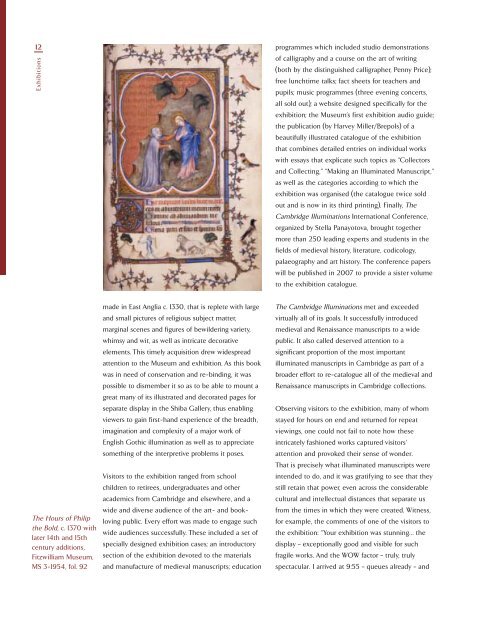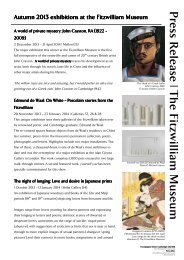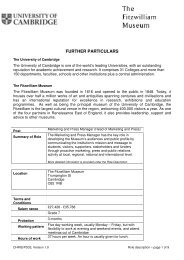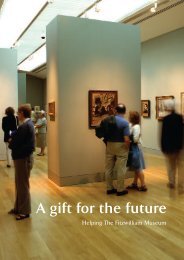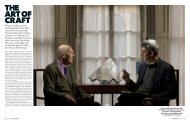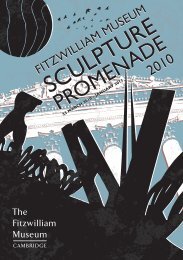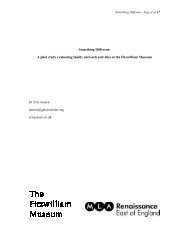The Fitzwilliam Museum - University of Cambridge
The Fitzwilliam Museum - University of Cambridge
The Fitzwilliam Museum - University of Cambridge
You also want an ePaper? Increase the reach of your titles
YUMPU automatically turns print PDFs into web optimized ePapers that Google loves.
12<br />
Exhibitions<br />
<strong>The</strong> Hours <strong>of</strong> Philip<br />
the Bold, c. 1370 with<br />
later 14th and 15th<br />
century additions,<br />
<strong>Fitzwilliam</strong> <strong>Museum</strong>,<br />
MS 3-1954, fol. 92<br />
made in East Anglia c. 1330, that is replete with large<br />
and small pictures <strong>of</strong> religious subject matter,<br />
marginal scenes and figures <strong>of</strong> bewildering variety,<br />
whimsy and wit, as well as intricate decorative<br />
elements. This timely acquisition drew widespread<br />
attention to the <strong>Museum</strong> and exhibition. As this book<br />
was in need <strong>of</strong> conservation and re-binding, it was<br />
possible to dismember it so as to be able to mount a<br />
great many <strong>of</strong> its illustrated and decorated pages for<br />
separate display in the Shiba Gallery, thus enabling<br />
viewers to gain first-hand experience <strong>of</strong> the breadth,<br />
imagination and complexity <strong>of</strong> a major work <strong>of</strong><br />
English Gothic illumination as well as to appreciate<br />
something <strong>of</strong> the interpretive problems it poses.<br />
Visitors to the exhibition ranged from school<br />
children to retirees, undergraduates and other<br />
academics from <strong>Cambridge</strong> and elsewhere, and a<br />
wide and diverse audience <strong>of</strong> the art- and bookloving<br />
public. Every effort was made to engage such<br />
wide audiences successfully. <strong>The</strong>se included a set <strong>of</strong><br />
specially designed exhibition cases; an introductory<br />
section <strong>of</strong> the exhibition devoted to the materials<br />
and manufacture <strong>of</strong> medieval manuscripts; education<br />
programmes which included studio demonstrations<br />
<strong>of</strong> calligraphy and a course on the art <strong>of</strong> writing<br />
(both by the distinguished calligrapher, Penny Price);<br />
free lunchtime talks; fact sheets for teachers and<br />
pupils; music programmes (three evening concerts,<br />
all sold out); a website designed specifically for the<br />
exhibition; the <strong>Museum</strong>’s first exhibition audio guide;<br />
the publication (by Harvey Miller/Brepols) <strong>of</strong> a<br />
beautifully illustrated catalogue <strong>of</strong> the exhibition<br />
that combines detailed entries on individual works<br />
with essays that explicate such topics as “Collectors<br />
and Collecting,” “Making an Illuminated Manuscript,”<br />
as well as the categories according to which the<br />
exhibition was organised (the catalogue twice sold<br />
out and is now in its third printing). Finally, <strong>The</strong><br />
<strong>Cambridge</strong> Illuminations International Conference,<br />
organized by Stella Panayotova, brought together<br />
more than 250 leading experts and students in the<br />
fields <strong>of</strong> medieval history, literature, codicology,<br />
palaeography and art history. <strong>The</strong> conference papers<br />
will be published in 2007 to provide a sister volume<br />
to the exhibition catalogue.<br />
<strong>The</strong> <strong>Cambridge</strong> Illuminations met and exceeded<br />
virtually all <strong>of</strong> its goals. It successfully introduced<br />
medieval and Renaissance manuscripts to a wide<br />
public. It also called deserved attention to a<br />
significant proportion <strong>of</strong> the most important<br />
illuminated manuscripts in <strong>Cambridge</strong> as part <strong>of</strong> a<br />
broader effort to re-catalogue all <strong>of</strong> the medieval and<br />
Renaissance manuscripts in <strong>Cambridge</strong> collections.<br />
Observing visitors to the exhibition, many <strong>of</strong> whom<br />
stayed for hours on end and returned for repeat<br />
viewings, one could not fail to note how these<br />
intricately fashioned works captured visitors’<br />
attention and provoked their sense <strong>of</strong> wonder.<br />
That is precisely what illuminated manuscripts were<br />
intended to do, and it was gratifying to see that they<br />
still retain that power, even across the considerable<br />
cultural and intellectual distances that separate us<br />
from the times in which they were created. Witness,<br />
for example, the comments <strong>of</strong> one <strong>of</strong> the visitors to<br />
the exhibition: “Your exhibition was stunning… the<br />
display – exceptionally good and visible for such<br />
fragile works. And the WOW factor – truly, truly<br />
spectacular. I arrived at 9:55 – queues already – and


